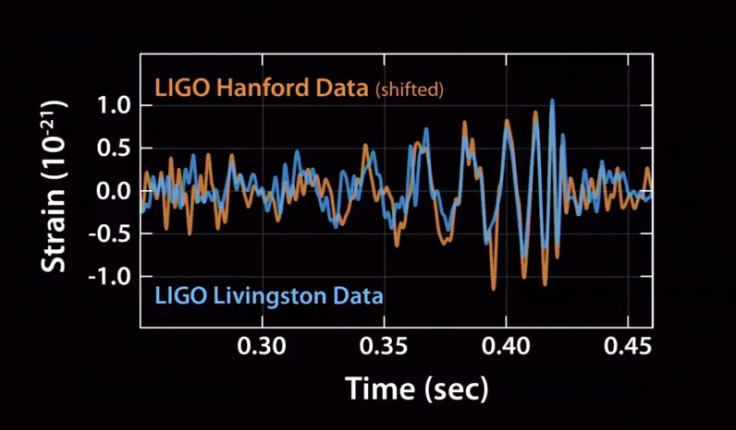LIGO gravitational wave detection: Tremendous discovery opens whole new universe

Gravitational waves have been detected for the first time using the LIGO Interferometer, with ripples in spacetime discovered emanating from two black holes spiralling around one another. The discovery of the 1.3 billion-year-old signals was announced at a press conference at the National Science Foundation, and a peer-reviewed paper explaining the findings has been published in the journal Physical Review Letters.
But what does it all mean? Bobby Acharya, professor of yheoretical physics at King's College London, told IBTimes UK that while the physics were not unexpected – "it was predicted by Einstein literally 100 years ago" – it is a "tremendous" announcement that will provide a whole new way of observing the universe.
Explaining the science behind it, Acharya said the gravitational interaction between, say, the Earth and the Moon results in the loss of energy – equivalent to about 200 watts. If you change the distance between the two objects, or their masses, this energy amount will also change.
"What they [LIGO scientists] have observed is something quite similar – two objects rotating around each other, but in fact these are much heavier than the Earth or Moon," he said.
"They are two black holes whose masses are roughly each about 30 times the mass of the Sun and what they have observed is the gravitational energy that's released in the form of this wave, which ripples through the gravitational field when these two black holes coalesce – they are spiralling towards each other and they coalesce into a much bigger and heavier black hole.
"That process is quite violent and releases a lot of energy and that's what they've observed. It's almost 100 times more the power of all of the stars in the entire universe. It's a huge amount of power, but it only lasts for a fraction of a second."

Gravitational waves can be thought of as like the ripples that emanate in a pond when a stone is thrown in. This ripple from the black holes has reached us, and that is what LIGO detected. Why is this important? As mentioned, Einstein first suggested gravitational waves in the theory of general relativity 100 years ago. Since then, physicists accepted their existence and used them for theories about space. But proving their existence was another matter – the distances that needed to be measured were around 1,000 times smaller than a proton. So you need an extremely sensitive way of measuring it – and that's where the Interferometer came in.
The detection of gravitational waves is fairly similar to the discovery of the Higgs boson at Cern – scientists predicted its existence, but had not been able to prove it without the Large Hadron Collider. "That was a tremendous breakthrough in physics," Acharya said. "It opened the doors to many new directions in particle physics, ideas, lots of physics.
"This [the discovery of gravitational waves] is just classical gravity. But gravity, because it's such a weak force, it's very hard to observe the actual wave itself. This really opens up a whole new epoch of observations.
"I work on many different areas of particle physics, mostly fundamental. The physics of the early universe. What is dark matter? What generated the seeds in the early universe for what eventually became our galaxies? Early universe cosmology is one area where gravitational wave detectors could make measurements. For example, many theories, including some I've worked on like super string theory, predict cosmic super strings – microscopic extended objects that stretch across the universe – those strings could emit gravitational waves. It might be possible to observe those in the future.
"There's loads of astrophysics to be done. An observation of a binary black hole that merges into one. That's amazing. That's an incredible observation. This is basically saying that actually happened and it's been observed through these waves."
On what the discovery means for the future, he added: "Now we've shown this is possible it means we can go on to look at the universe through gravitational waves. We're so used to looking at the universe using light and radio waves and x-rays, now we can actually look at the universe using gravitational waves. It's a whole new way of looking. This is really a tremendous achievement."
© Copyright IBTimes 2025. All rights reserved.






















